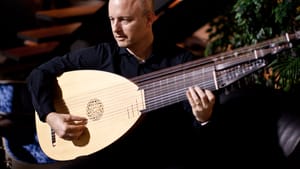Stay in the Loop
BSR publishes on a weekly schedule, with an email newsletter every Wednesday and Thursday morning. There’s no paywall, and subscribing is always free.
Pleasures of the recorder and lute
Tempesta di Mare does Venice and Naples

Most people nowadays probably think of the recorder as a children’s instrument. Schoolchildren can learn to play simple tunes on it fairly quickly and start piping away while young violinists and flutists are still trying to coax a decent sound out of their instruments. But in the Baroque era, the recorder was the standard flute for much of the period. Baroque composers created a library of recorder concertos and sonatas that demand virtuoso performers.
The Italian name for the recorder is il flauto dolci — the sweet flute — but that sweetness requires tight control of tone and volume when you’re playing solo lines created by composers like Scarlatti and Vivaldi.
At Tempesta di Mare’s latest outing, co-director Gwyn Roberts played three beautiful examples of the excitements and pleasures that recorder players can produce when they’ve worked their way into the top rankt of their profession. I’ve followed her career for more than 25 years, and you could hear those decades of development in every note she played. In the opening item on the program, Vivaldi’s La Notte, Roberts captured a gamut of nighttime emotions, from frenzied fear to relief at the coming of the day. When the birds sang to the sunrise at the end, I heard the birds and saw the morning.
Seduced by Vivaldi
Roberts and her co-director, lute player Richard Stone, have assembled a full Baroque orchestra, with brass and percussion, but Tempesta di Mara’s season schedule includes recitals and chamber music concerts as well. This concert sampled chamber music from two Italian musical capitals, Venice and Naples. The eight pieces on the program were a one-to-a-part showcase for six of Tempesta’s principal players.
Stone’s big solo was one of the established hits of the Baroque repertoire: Vivaldi’s exuberant Lute Concerto in D. In his remarks before he launched into the concerto, Stone said it was the piece that attracted him to classical music when he was a child. I can understand that. A recording of the concerto clinched my growing interest in Baroque music.
I responded to the fast outer movements the first time I heard it. Stone says it was the beautiful inner movement that “did it” for him. He was obviously a more sensitive listener (at a much younger age), but we both seem to have reached the same judgment. Movement by movement, the concerto is one of the best things Vivaldi ever wrote.
Stone gave it a performance worthy of my memories, with the lute providing an exhilarating first movement, a dreamy visit to another world in the slow movement, and a final allegro packed with rustic drive. The small forces kept the accompaniment in perfect balance with the solo instrument.
Commercial instincts
The two violinists in the sextet, Emlyn Ngai and Karina Schmitz, mostly played ensemble roles, but they generated a sonorous field of sound that permeated the whole program. They provided much of the rustic atmosphere in the final movement of the lute concerto, and there was a memorable interlude, in another piece, when the spotlight focused on the recorder’s interactions with Karina Schmitz’s violin.
Lisa Terry and Adam Pearl supplied the indispensable basso continuo — the combination of bass line and chords that formed the rhythmic and harmonic foundation of Baroque music. Terry provided the bass line on her cello, as she usually does, and Pearl played a small organ, instead of the harpsichord that he usually plays. The organ is a perfectly acceptable continuo instrument, and it added a touch of dramatic flair in the appropriate places.
Richard Stone reinforced the continuo on the lute and added to the variety by switching to the small Baroque guitar for the last four pieces. Baroque composers had sound commercial instincts; their published works usually advised potential customers that a piece could be played on a variety of instrumental combinations, depending on what you happened to have on hand. They wouldn’t have objected to a little fooling around with the continuo, and I think we can take it for granted they would have been quite happy with the level of musicianship the Tempesta Six bestowed on their music.
What, When, Where
Tempesta di Mare: “A Tale of Two Italian Cities.” Vivaldi, Lute Concerto in D; Recorder Concerto La Notte; Scarlatti, Sonata a quattro for recorder, violins and continuo; Mancini, Concerto in A Minor; Castello, Sonate concertante in stil moderno, nos. XV and XVI; Legrenzi, La Cetra, nos. 1 and 5; Falconieri, Canzona. Gwyn Roberts, recorder; Emlyn Ngai and Karina Schmitz, violins; Lisa Terry, cello; Richard Stone, lute; Adam Pearl, organ. April 23, 2016 at Arch Street Meeting House, 320 Arch St., Philadelphia. (215) 755-8776 or www.tempestadimare.org.
Sign up for our newsletter
All of the week's new articles, all in one place. Sign up for the free weekly BSR newsletters, and don't miss a conversation.

 Tom Purdom
Tom Purdom